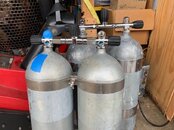They're the same cylinders as the 3442 PSI PST E7 series except for what's stamped on the shoulder of the cylinder and the size of valve they take, give or take manufacturing tolerances.
It's such unsubstantiated and unequivocal (and, I think, technically incorrect) statements that made me make the list in the first place!

You hear things like that, but that doesn't make it true.
Here is a photo of two sets of doubles. The rear one is a PST E7-100 (3442) and the front one is a PST HP100 (3500). They are demonstrably different. Notice the clear line where the slope of the shoulder starts and the relatively sharp, flat angle of the HP's. Notice that the E7's are much more rounded. In the end, it makes about a 1/2" difference in height. They are also demonstrably different in *weight*, and that means that the actual blank used to form the thing is different.
And these are not "manufacturing tolerances". Notice that both 3500's are similar, and both 3442's are similar. They are clearly manufactured with slightly different techniques.
Now this may have less to do with the difference between 3500 and 3442, and more to do with the fact that the 3442's are 10+ years *newer*, and that E7-100's made 10 years after mine would be different, too, yet still be E7-100's. But it does not change the statement: there are differences between the two. And when you make categorical statements ('these are identical except for *tolerance* differences'), these differences show those statements to be categorically wrong.
But does it matter in reality? That's what I wanted to see for myself. Which is why I wanted as accurate information as I could get -- from the manufacturer. From everything I've been able to find, the differences are so small as to be meaningless.
But that continues for more than just the PST 3500 vs 3442 debate. Worthingtons have a reputation for being heavy tanks, right? Except when the Worthingtons are *lighter* than Fabers: see the HP100's; even when they are heavier, it's often a pound or less (out of 30+ pounds!). Of course, you have to read things correctly: often Faber tanks buoyancy are quoted *without* valves, when *everyone* else quotes it with. Add the change for a valve (how do you even *measure* a full tank without a valve!?!) and they're all right there with each other... (Of course, that opens up more questions: which valve did each manufacturer use? How heavy was it?)
Honestly, for me the biggest takeaway was this: the differences are slight. Don't get hung up on them. And don't take *any* number as gospel!





